The Economics and Statistics Division maintains archives of previous publications for accountability purposes, but makes no updates to keep these documents current with the latest data revisions from Statistics Canada. As a result, information in older documents may not be accurate. Please exercise caution when referring to older documents. For the latest information and historical data, please contact the individual listed to the right.
<--- Return to Archive
For additional information relating to this article, please contact:
October 01, 2021CANADA GDP BY INDUSTRY, JULY 2021 With July reference month results, year-over-year (July 2021 vs July 2020) and year-to-date (Jan-Jul 21 vs Jan-Jul 20) are showing the rebounds in economic activity from the unprecedented declines observed at the start of the COVID-19 pandemic.
Real Gross Domestic Product (GDP) in Canada decreased 0.1% in July 2021, following a 0.6% increase in June 2021. For the month, activity was up in 13 of 20 industrial sectors, led by strong monthly gain in accommodation and food services. Declines in agriculture, utilities, manufacturing and wholesale trade offset the gains.
The Canadian economy was 1.9% smaller when compared to pre-pandemic February 2020 with an annualized value of $1,963 billion (chained 2012 dollars) in July 2021.
Statistics Canada’s preliminary estimate for real GDP points to an approximate 0.7% increase in August 2021. Rising accommodation and food, manufacturing an and retail are supportive while drought conditions negatively impact agriculture again in August. The official GDP data for August 2021 will be published on October 29, 2021.
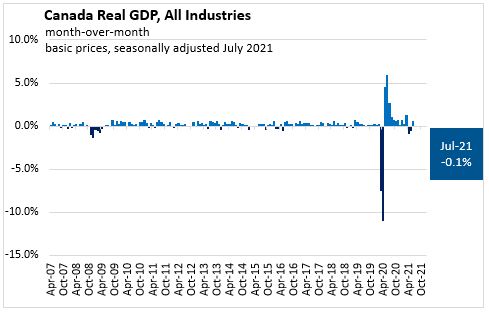
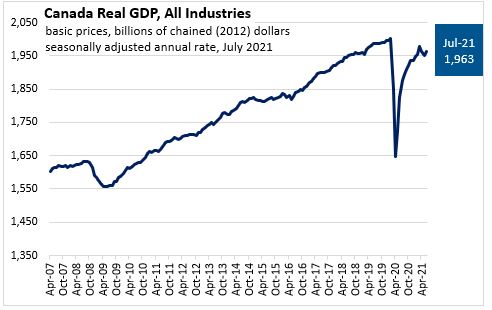
Goods-Producing Industries
Goods-producing sector output declined 1.4% month-over-month in July 2021 as declines in activity occurred for most of the subsectors.
Extreme heat in western Canada impacted the agriculture, forestry and fishing sector in July, resulting in a 5.5% GDP decline. Crop production (except cannabis) declined 13.2% to it's lowest level since 2007 with drought conditions impacting wheat, canola and other grains. Animal production rose 2.9%. Forestry and logging declined 3.9% with forest fires in British Columbia and northwestern Ontario.
Utilities declined 4.9% in July after rising 3.6% in June. Electric power generation, transmission and distribution (-6.0%) decreased as cooler-than-usual temperature in central and eastern Canada led to overall decline despite the heat wave in western Canada. Natural gas distribution, and water, sewage and other systems also fell this month.
Manufacturing was down 1.1% in July as durable manufacturing (-1.9%) declined for the third time in the past four months. Miscellaneous, fabricated metal products, and non-metallic mineral product manufacturing were the primary subsectors of decline. Non-durable goods manufacturing edged down (-0.1%) with a even mix of gains and losses among the subsectors. Food and plastic and rubber products were up while chemical, printing and related support activities and petroleum and coal product manufacturing declined.
Construction declined (-0.9%) for the third consecutive month on continuing lower residential building construction in Canada. Residential building construction was down 2.7%, led by lower single-family homes, and home alterations and improvements. Non-residential building construction (+0.5%) and engineering construction (+1.1%) rose this month.
Services-Producing Industries
Output of the services-producing sector increased 0.4% in July 2021.
With easing of public health measure, the accommodation and food services sectors increased 12.5% in July following a 12.0% increase in June. Food services and drinking place was up 9.5% with summer weather, expanded patio capacity and loosened restriction on indoor dining across the country. Accommodation services gained 21.2% in July with rising domestic and international travel.
Arts, entertainment and recreation sector was up 8.1% on eased restriction in many places allowing for increased activity at amusement parks, casinos, and recreational facilities (gyms, yoga studios, pools, and arenas).
Transportation and warehousing grew 1.1% with air transportation (+67.7%) leading the way. Air transportation remains close to 83% below pre-pandemic levels of activity. Rising movement of goods and increased public transit ridership also were positive while postal service, couriers and messengers, and rail transportation fell.
Wholesale trade was down for a fourth consecutive month, the 1.9% decline was due to contractions in 7 of 9 subsectors and building material and supplies wholesaling (-9.0%) accounting for most of the decline. Retail trade decreased 1.1% with 7 of 12 subsectors posting declines.
Public sector grew 0.4% with gains in all 3 sectors: educational services (+0.5%), health care and social assistance (+0.6%) , and public administration(+0.2%).
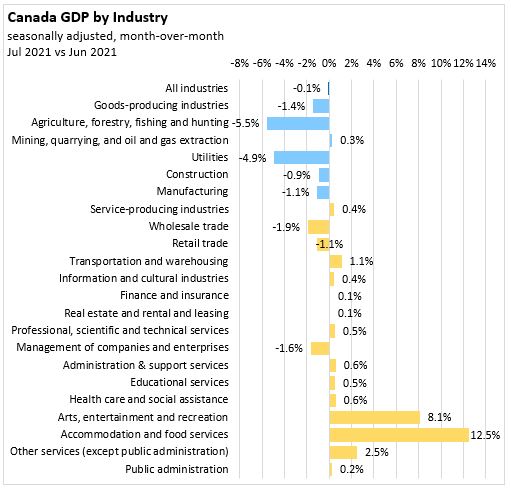
July 2021 vs February 2020
Canadian real GDP was 1.9% lower when compared to February 2020.
Amid the COVID-19 pandemic and economic recovery, the sectors with the current largest declines in activity are in arts, entertainment and recreation (-46.2%), and management of companies and enterprises (-28.4%), accommodation and food services (-21.3%). For July 2021, all goods-producing industries were at lower levels of activity than February 2020. Activity has increased in some private service sectors compared to February 2020: finance and insurance (+5.3%), information and cultural (+2.4%), retail trade (+2.1%), real estate and rental and leasing (+2.1%), and professional, scientific and technical services (+1.4%). Public sector GDP has increased from February 2020.
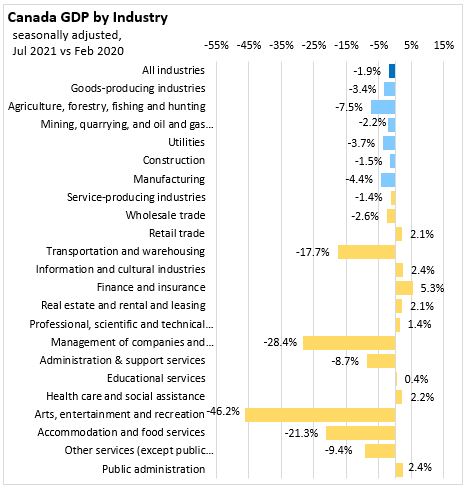
Year-Over-Year (July 2021 vs July 2020)
Canadian real GDP was 4.7% higher than in July 2020.The largest rebounds, in percentage terms, have been in accommodation and food services, arts, entertainment and recreation, health care and social assistance, and other services (personal, repair). Agriculture, forestry, and fishing, utilities , and management of companies and wholesale trade had lower GDP in July 2021 than July 2020.
Year-to-Date (Jan-Jul 2021 vs Jan-Jul 2020)
The Canadian economy in the first seven months of 2021 increased 6.3% compared to the same period in 2020.
Compared to the same period last year, the largest increases in activity have been in health care and social assistance (+12.4%), retail trade (+11.8%), and wholesale trade (+8.9%). Activity decreased the most in arts, entertainment and recreation (-20.0%) and management of companies (-17.7%).
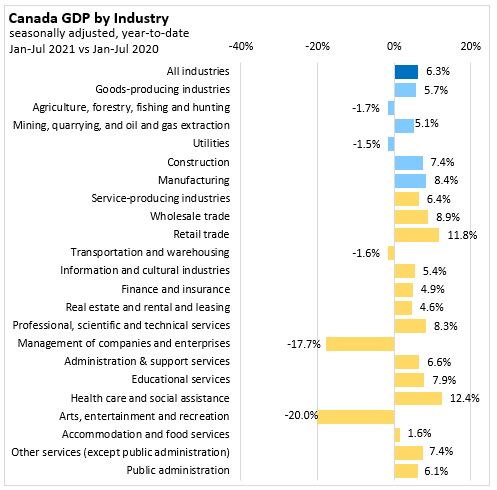
Source: Statistics Canada, Table 36-10-0434-01 Gross domestic product (GDP) at basic prices, by industry, monthly (x 1,000,000)
<--- Return to Archive